Final Report: Taking it to the next level: Galleries, Libraries Archives, and Museums (GLAMs) Summit 2018
Message from the Librarian and Archivist of Canada, and the CEO and Executive Director of the Canadian Museums Association
At the end of our discussions at the first Summit in December 2016, which had as an objective to present the current state of research on the social and economic value of memory institutions and to highlight examples of innovation, we collectively adopted the Ottawa Declaration. The Declaration was a commitment to moving forward based on a shared recognition of how much we, the galleries, libraries, archives and museums (GLAMs) sector, have in common, and the opportunities and benefits of working collaboratively. The Ottawa Declaration stated that, together, we would:

Guy Berthiaume, Librarian and Archivist of Canada

John McAvity, President-DG of Canadian Museums Association
- Increase collaboration between our institutions and our networks at the local and national levels to catalyze new partnerships that spark creativity and enhance engagement;
- Develop innovative programs and services, and adopt technologies that empower us to engage our publics; and;
- Enrich and expand access to our collections to ensure that our institutions contribute significantly to the public good and sustainable development.
To keep the momentum going after the first Summit, we created a working group to put the Ottawa Declaration into action. The working group is co-chaired by both of us, and we have assembled a cadre of six members with expertise from across the GLAM sectorFootnote 1. The mandate of the working group is to explore and study how GLAMs bring value to Canadian society, and to help identify areas where partnerships could be developed.
During the last year, we have worked on scoping out what a study on the value of the GLAM sector should look like, so that we encompass the reality of these types of institutions.
We worked to identify new partnerships that spark creativity and enhance engagement. The Canadian Urban Libraries Council surveyed its members on this very topic last summer, so we will be expanding their results to include museums, galleries and archives soon.
We have also undertaken an environmental scan of the cultural policies of Canada, Italy, Spain, France and the United Kingdom, with a view to exploring the eventual gaps and potential need to equip our country with a national cultural policy in which GLAMs would play a key role.
During the first Summit, Maureen Sawa hit the nail on the head when she said that instead of looking at doing more with less, our goal should be to do more with more. More collaboration, more partnerships, more outreach, more relevance. Let us work together, so all of us, individually and collectively, can do more with more.
In this second Summit of the GLAM sector, foundational elements of a narrative that demonstrates the value and breadth of the benefits of GLAMs to the society were identified. This report is a first attempt to present these elements to prepare for the next exchanges.
Acknowledgment
Library and Archives Canada and the Canadian Museums Association would like to thank the Royal Ontario Museum, the Canadian Commission for UNESCO, and Ecclesiastical Insurance Canada, without whom the 2018 Summit would not have been possible.
Synopsis
The co-chairs of the Ottawa Declaration Working Group invited members of the GLAM sector to join them in a second Summit, entitled “Taking It to the Next Level,” held on January 30, 2018. Building on the success of the first Summit on the value of GLAMs held on December 5 and 6, 2016, this 2018 Summit, hosted at the Royal Ontario Museum in Toronto, brought together practitioners and experts to engage in a day of discussion that focused on the following four themes:
- Communities: How can collaboration among GLAMs benefit local communities, as well as provide greater opportunities for building links and fostering community identity?
- Indigenous peoples: How can GLAMs work more closely with Indigenous peoples to renew mutual relationships that are based on understanding and respect?
- Private sector: How can GLAMs collaborate with the private sector to encourage greater innovation?
- Government priorities: How can GLAMs work with various levels of government?
The Summit welcomed some 280 participants, and the associated hashtag #GLAM2018 was trending all day, moving between first and twelfth place in Canada’s top trending themes. For a summary of the Summit through the eyes of Twitter, please see Sarah J. McCabe’s Top Tweets from GLAMs Summit 2018.
A Compelling Story: The Need for a Narrative
“You need to know who you are first.” – Angela Cassie
The need for a supporting narrative that demonstrates the value and breadth of the social benefits of GLAMs emerged as the core theme of the Summit. In his opening remarks, John McAvity set the stage by calling on GLAM institutions to find ways to improve public perception, to ensure that they will no longer be taken for granted by the general public. Immediately afterwards, Senator Patricia Bovey, in her keynote speech, spoke of the need to go beyond the current metrics that measure the economic and social impact of the GLAM sector, arguing that such metrics are limited by a narrow view and too short a period. She said a broader, more unified narrative would serve to support and nurture relationships with both GLAMs and non-GLAMs.
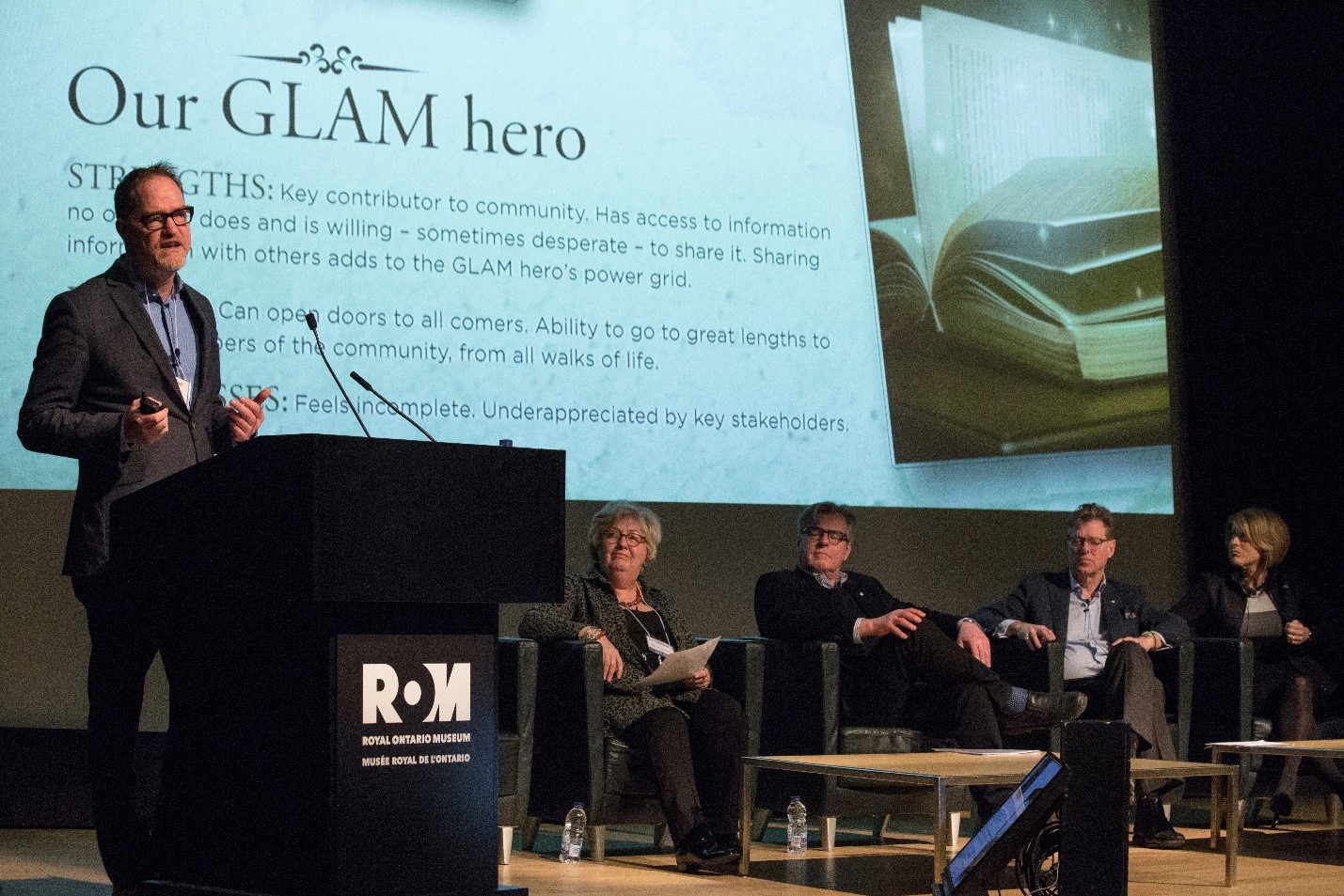
Chris Kitzan, Vickery Bowles, Doug Knight, Rupert Duchesne and Andrea Cohen Barrack
For the remainder of the day, a number of speakers and panellists also addressed the need for a narrative, a compelling story, a “meta-narrative”, a need to show relevance, to show why GLAMs matter or what GLAMs have to offer to partners. Speakers Daphne Wood, Chris Kitzan, Angela Cassie, Jack Lohman, Tim Johnson, Sara Diamond and Doug Knight all alluded to this need in some way.
Given the capacity challenges the GLAM sector faces, ongoing collaboration and partnerships were held up as an antidote. The Summit participants suggested that to leverage those opportunities across and beyond the GLAM sector, a sound and comprehensive narrative focused on long-term social benefits would allow the GLAM sector to better engage with other sectors of activity, whether private, governmental or not-for-profit.
Toward a Foundational Narrative
Taken as a whole, the various presentations and panel discussions held throughout the Summit provided a foundational narrative about the role of GLAMs in society. The remainder of this report identifies these main crosscutting themes, and presents the argument that these themes could be, in some form or another, the underlying narrative that GLAMs are seeking to establish, and a foundation upon which they might build.
A Different Collaboration: Yearning for a Relationship
"These people wish to be partners with us in our country. We must, therefore, be the same as brothers to them, and live as one family. We will share equally in everything—half and half—in land, water and timber, etc. What is ours will be theirs, and what is theirs will be ours. We will help each other to be great and good." – Memorial to Sir Wilfrid Laurier from the Secwepemc, Okanagan and Thompson chiefs, quoted by Chief Dr. Ronald Ignace
Collaboration, as was the case during the first Summit, was again a consistent theme throughout the day’s events. However, this year’s event saw collaboration better tracked and described, particularly with respect to how the GLAM sector adds value to such partnerships.
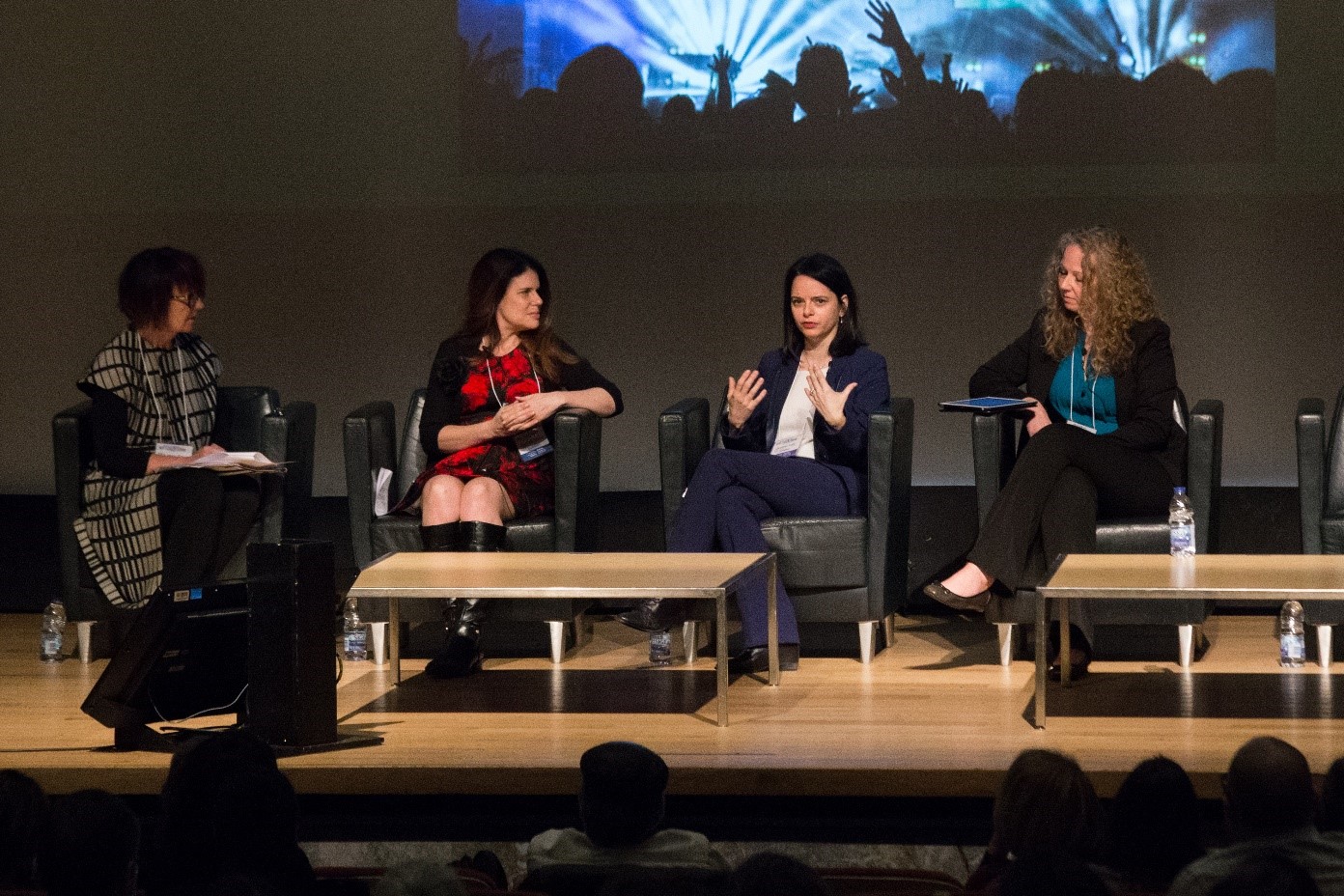
Maureen Sawa, Daphne Wood, Heather Kelly and Andrea Stewart
Andrea Stewart, among others, posited the main rationale for why collaboration is beneficial for the GLAM sector: Collaboration provides a means to leverage the expertise and resources of others; to allow participation in new funding opportunities; to increase visibility for all parties involved; to support a strategic approach; and ultimately, to allow for expertise to move across multiple networks.
Both Chief Dr. Ronald Ignace and Heather Kelly emphasized that collaboration among GLAM sector institutions must be done in a fair manner to ensure that all parties benefit equally. Chief Dr. Ignace argued for true reciprocity in the context of the United Nations Declaration on the Rights of Indigenous PeoplesFootnote 2 and the relationships between the GLAM sector and Indigenous peoples and communities. This concept was underscored by Heather Kelly, who argued that true and effective collaboration could be attained only when all partners are considered equal and goals of mutual benefits are pursued from inception.
Finally, both Andrea Cohen Barrack and Rupert Duchesne made the case for new types of collaboration with sectors outside the realm of GLAMs. They made the point that the old ways of philanthropy were out of date. They pointed out that given that businesses want to establish relations at are coherent with the brand and goals of institutions) that collaboration needs to be conceived as a reciprocal relationship, an investment benefitting all parties on a long-term basis. Both Susan Wright and Chris Kitzan presented a number of strong examples of partnerships and exchange of expertise undertaken by the Toronto Public Library and the Canada Aviation and Space Museum.

Tim Johnson, Petal Furness, Chief Dr. Ronald E. Ignace and Alan Ojiig Corbiere
In the context of building a narrative, it is crucial to demonstrate how the GLAM sector is both an established expert collaborator, and one that should aspire to advance this expertise in order to pursue and implement collaboration relationships with equal partners across even more sectors. As a trusted source of information made up of relied-upon connectors, the GLAM sector is in a unique position to exercise greater influence in Canadian society, and to foster new and enduring spaces for collaboration and discussion as a fundamental component of a foundational narrative for Canadian GLAMs.
Trusting the Facts: Providing a Space for Discussion
“GLAMs are institutions where facts are celebrated.” – Senator Patricia Bovey
For some time, GLAM institutions have been reflecting on their role and unique position in the context of the emergence of “fake news” and general misinformation, as well as the social and technological realities that catalyzed the generalization of these phenomenons. As mentioned by Mark Engstrom and others during the discussions, it is “real facts” that are of interest to GLAMs. Currently, GLAM institutions are (still) deemed trustworthy, and the whole sector should embrace this trust while being careful not to jeopardize it. As Jack Lohman pointed out, one of the main attributes of the nuanced discourse of GLAMs is allowing myriad facts to be exposed and juxtaposed. As aptly put by Senator Patricia Bovey, the strength of GLAMs, and therefore their value, rests in the “unique position to present multiple views on multiple issues—issues which affect us as individuals and those which affect us as communities and whole societies.”
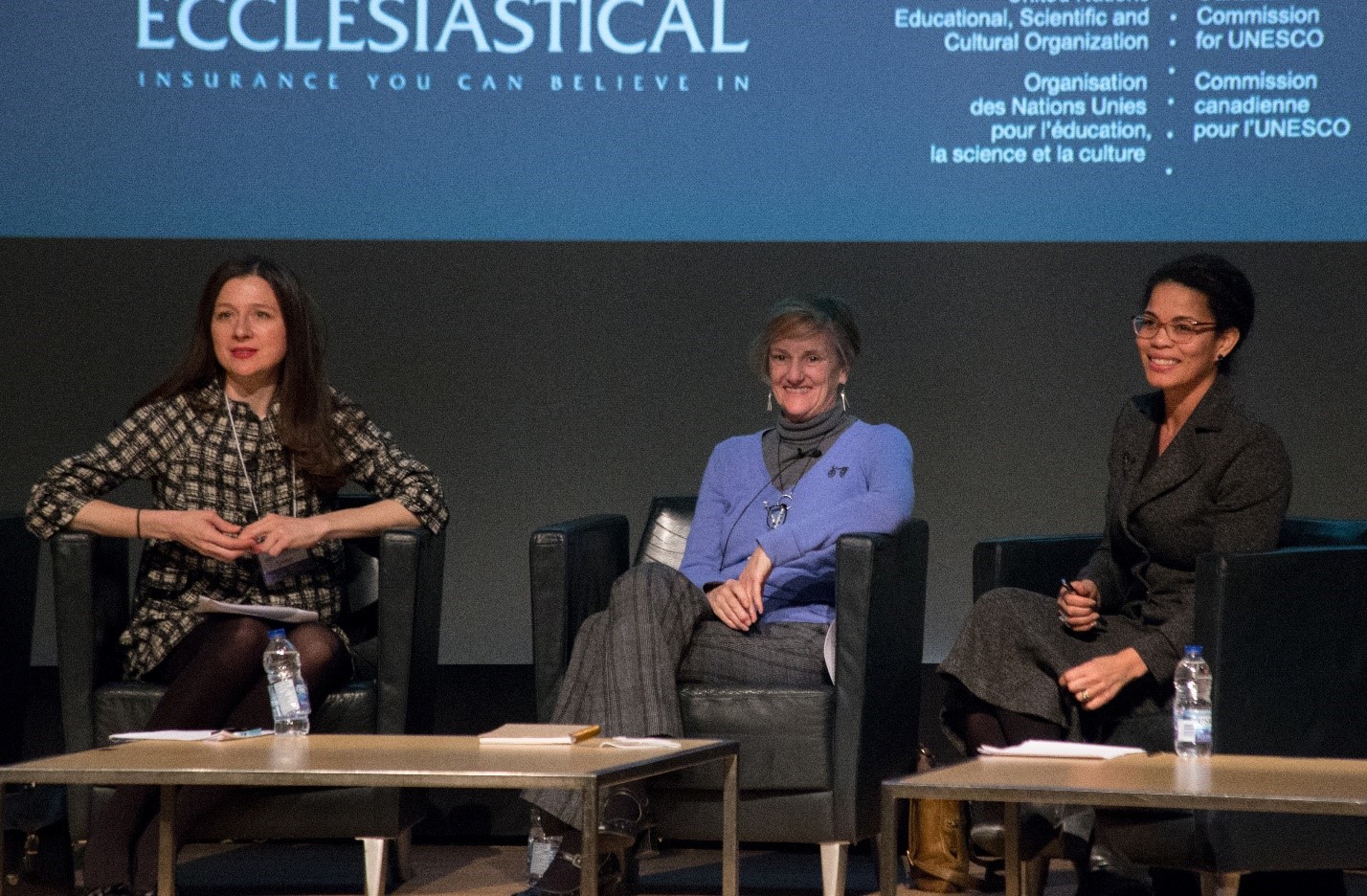
Jessica Johnson, Susan Wright and Angela Cassie
Libraries in particular have demonstrated that they are at the leading edge of technology and a potential gateway for public engagement with other memory institutions. The Toronto Public Library, the most visited library in North America, is certainly an example of digital best practices. Some of these, presented by Vickery Bowles (Toronto Public Library), included the library's multiple hackathons, meet-ups, and workshops and seminars for small businesses to help them understand and manage disruptive technologies and new business models, or the implementation of their very own Digital Innovation Hubs. Pam Wright (United States National Archives and Records Administration) and Mark O'Neill (Canadian Museum of History) presented participants with some of the innovative digital practices in the realms of archives and museums, respectively.
With a vast amount of material collected, preserved and made available to the public, memory institutions provide not only sources of information that affect public discourse and debate, but also spaces for discussion, both physical and digital, as elucidated by Susan Wright. Moving beyond providing an alternative to misinformation, these spaces for discussion are also spaces for educating and learning. These are long processes that are paramount to reconciliation and “understanding the other”—the next foundational piece of the narrative.
Giving a Voice Back to History: Understanding the Other
“My people will sleep for one hundred years, but when they awake, it will be the artists who give them their spirit back.” – Louis Riel, quoted by Tim Johnson
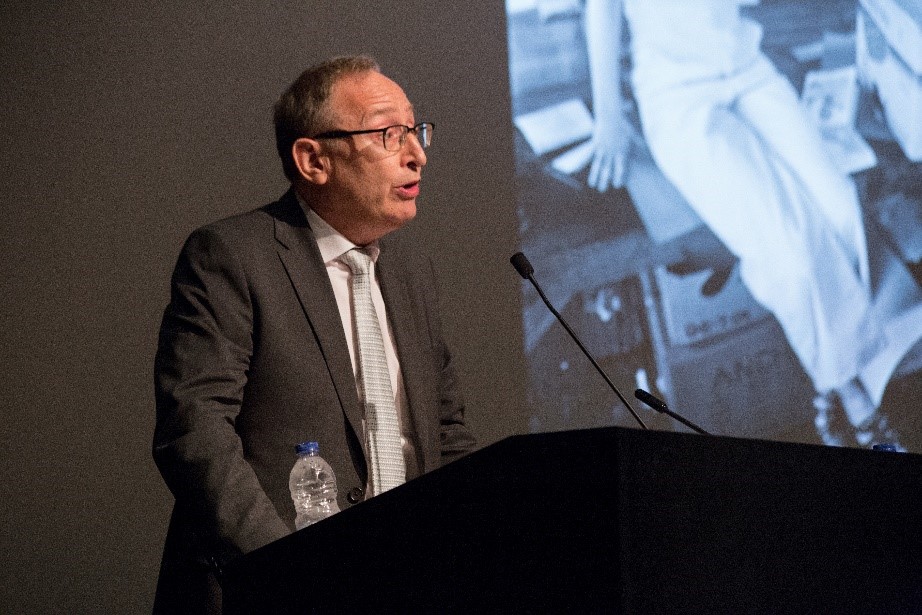
Jack Lohman
GLAMs also have a key role to play in the context of Indigenous language revitalization. With myriad documents, publications and recordings in Indigenous languages in their collections (books, letters, lexicons, dictionaries, interviews and more), GLAMs have much to offer Indigenous communities wishing to revitalize their languages. For example, GLAMs can acquire new material in Indigenous languages, make information available and accessible online, preserve objects for posterity, and support the capacity of Indigenous communities to manage and safeguard their language-revitalization records.
In a society where many remain marginalized, the GLAM sector, with its nuanced approach, provides a space for all sides to redefine the context of their experience, thereby increasing awareness, understanding and social inclusion in the process. The GLAM sector actively contribute to the public discourse. Especially in the context of reconciliation, as mentioned by Chief Dr. Ignace, “our connection with our past as stored in museums is troubled”. GLAMs have an opportunity to help rebuild this connection to the past. Given the digital environment in which society now operates, discussion in digital space opens us up to a global audience. The result has been that the GLAM sector has become an international contributor, which is the fourth and final pillar of the foundational narrative.
Beyond Our Borders: A Global Audience
“We [the GLAM sector] have a moral obligation to act as a pressure group.” – Jack Lohman
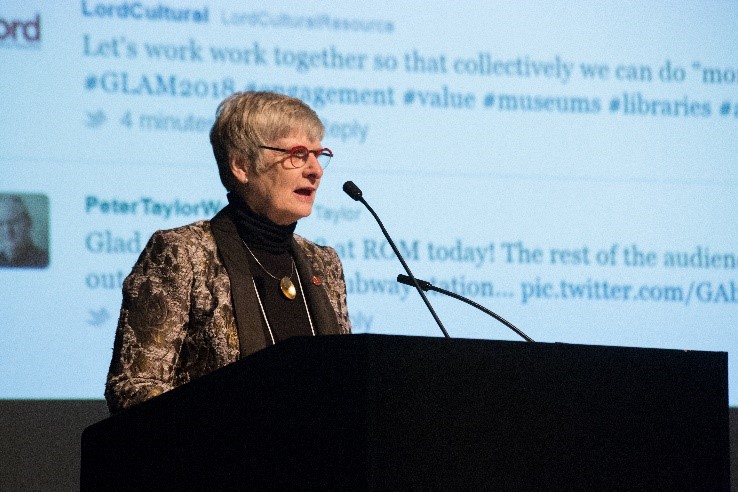
Senator Patricia Bovey
On more than one occasion, the international role of culture and the arts was put forward. By virtue of being part of essentially all major trade agreements, in part through discussions on copyright and intellectual property, the arts are also a key area of potential for entering into partnerships with other nations. Furthermore, arts and culture are an important draw in terms of tourism and associated economic development. Through the global sharing of information, Canada is able not only to showcase its arts and culture to an international audience, but also to share foundational elements of its history. As the custodians and experts of the country’s cultural past and present, the GLAM sector is in an advantageous position to play a significant role in the establishment of an international cultural identity for Canada.
Summit I: Other Elements of a Narrative

Dr. Sara Diamond
Revisiting the first Summit also provides some elements for a foundational narrative on the value of GLAMs for Canadian society. Among these is the idea that GLAMs play a fundamental role in the world of culture by empowering and enabling creators. GLAMs, therefore, play a role at both ends of the creative spectrum, going beyond simply acquiring the cultural outputs generated by Canadians, to act as a catalyst for creation; they provide inspiration at one end, and collect and preserve creative works already created at the other.
The goal of the GLAM foundational narrative is to extend conceptions of value beyond the realm of simple economic impact. Of course, this element cannot be ignored. Economic impact studies commissioned by the British Library, the Toronto Public Library and the Ottawa Public Library have all determined that for every dollar invested in libraries, there is a return on investment of approximately five dollars, which is key.
Conclusion
“In Africa, we have a saying: If you want to go fast, go alone. If you want to go far, go together.” – Robin Jones Gunn, quoted by Chris Kitzan
If the first Summit was deemed a “launching pad for future collaboration that promises to strengthen the GLAM sector”, the second Summit strove to define the contours of a broad foundational narrative that articulates the many ways that GLAMs provide value to Canadian society. Now we must look at complementing the narrative with concepts that have not yet been addressed. Further to this work, the GLAM sector must ensure that the narrative equally supports all the sector. Finally, much work remains in the conceptualization of a potential Canadian cultural policy and the role of the GLAM sector in its development and implementation, not an easy task.
While there is undoubtedly considerable work still to be done, it is with “determined optimism”, as Daphne Wood put it, that the GLAM sector will undertake this venture.
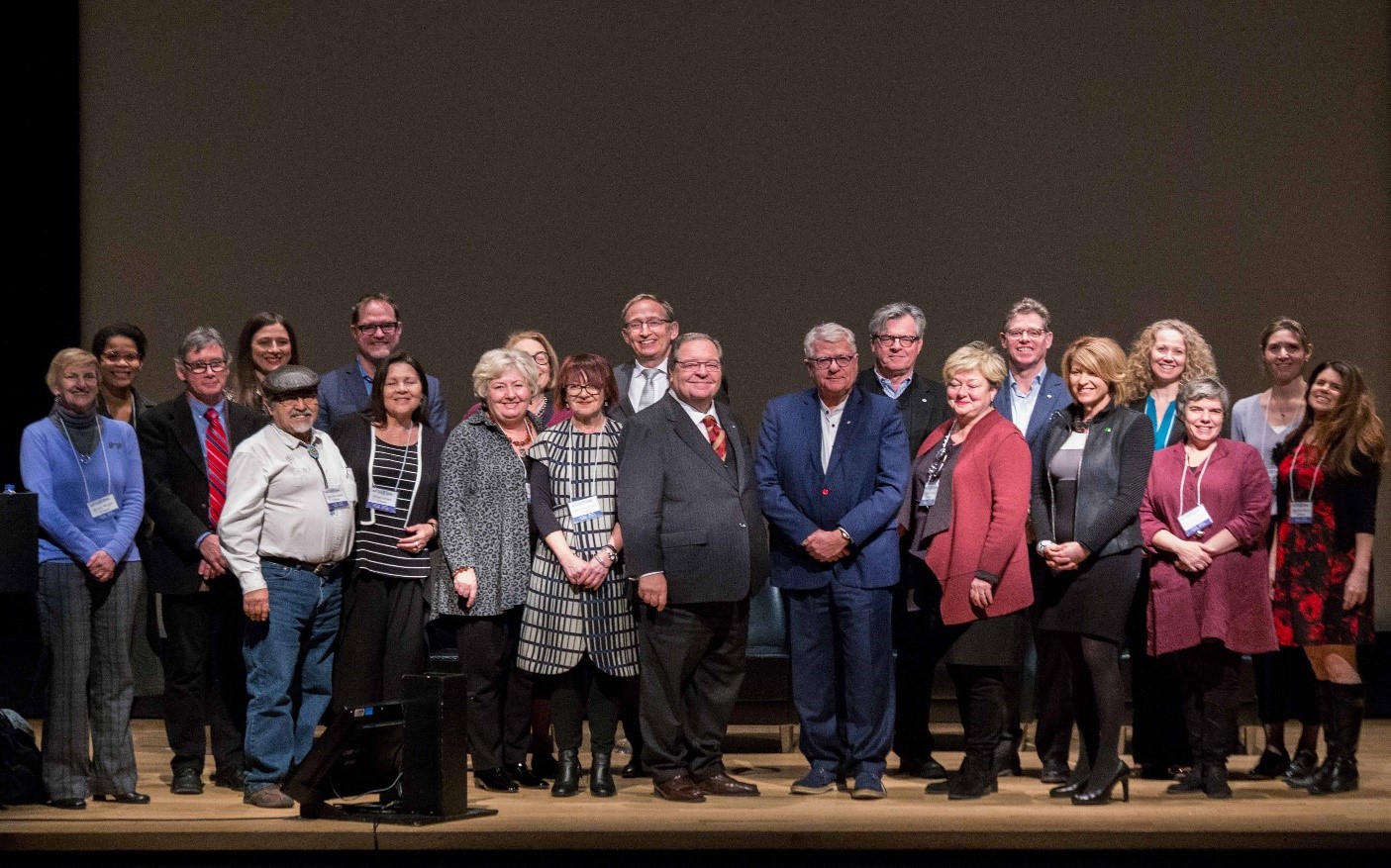
Susan Wright, Angela Cassie, Paul Gilbert, Sara Diamond, Chief Dr. Ronald E. Ignace, Chris Kitzan, Petal Furness, Vickery Bowles, Gail Lord, Maureen Sawa, Jack Lohman, Guy Berthiaume, John McAvity, Doug Knight, Marie Lalonde, Rupert Duchesne, Andrea Cohen Barrack, Andrea Stewart, Christine Lovelace, Dara Price and Daphne Wood
Appendix A: Summit Agenda
Agenda – Summit II: Taking It to the Next Level
Welcome and Opening Remarks
- MC: Dara Price, Director of Strategic Research and Policy, Library and Archives Canada
- Mark Engstrom, Deputy Director, Royal Ontario Museum
- Guy Berthiaume, Librarian and Archivist of Canada, Library and Archives Canada
Keynote Speaker:
- The Honourable Patricia Bovey, Independent Senator for Manitoba
Panel I: GLAMs and Communities
Moderator:
- Maureen Sawa, CEO, Greater Victoria Public Library and Past Chair, Canadian Urban Libraries Council
Panellists:
- Heather Kelly, Founder/Director, Bloor St. Culture Corridor
- Andrea Stewart, Co-Chair, Libraries, Archives and Museums Nova Scotia
- Daphne Wood, Past President, British Columbia Library Association
Panel II: GLAMs and Indigenous Communities
Moderator:
- Petal Furness, President, Ontario Museum Association and Museum Manager, Grey Roots Museum and Archives
Panellists:
- Alan Ojiig Corbiere, Anishinaabe Historian, M’Chigeeng First Nation
- Chief Dr. Ronald E. Ignace, Chief of the Skeetchestn Band
- Tim Johnson, Executive Producer of RUMBLE: The Indians Who Rocked The World
Keynote speaker:
- Sara Diamond, President and Vice Chancellor, OCAD University
Panel II: GLAMs and Indigenous Communities
Moderator:
- Petal Furness, President, Ontario Museum Association and Museum Manager, Grey Roots Museum and Archives
Panellists:
- Alan Ojiig Corbiere, Anishinaabe Historian, M’Chigeeng First Nation
- Chief Dr. Ronald E. Ignace, Chief of the Skeetchestn Band
- Tim Johnson, Executive Producer of RUMBLE: The Indians Who Rocked The World
Keynote Speaker:
- Sara Diamond, President and Vice Chancellor, OCAD University
Panel III: GLAMs and the Private Sector
Moderator:
- Vickery Bowles, Chief Librarian, Toronto Public Library
Speaker:
- Chris Kitzan, Director General, Canada Aviation and Space Museum
Discussants:
- Andrea Cohen Barrack, Vice President, Community Relations and Corporate Citizenship, TD Corporation
- Rupert Duchesne, Vice President, Board of Trustees, Art Gallery of Ontario
- Doug Knight, Chair and CEO, Governor General’s Performing Arts Awards Foundation
Panel IV: GLAMs and Government Priorities
Moderator:
Panellists:
- Angela Cassie, Vice-President, Public Affairs and Programs, Canadian Museum for Human Rights
- Susan Wright, Deputy Director, Toronto Arts Council
Keynote Speaker:
- Jack Lohman, CEO, Royal BC Museum
Closing Remarks
- Gail Lord, Co-Founder and President, Lord Cultural Resources
- Guy Berthiaume, Librarian and Archivist of Canada, Library and Archives Canada
- John McAvity, CEO and Executive Director, Canadian Museums Association
Appendix B: Infographics
Figure 1
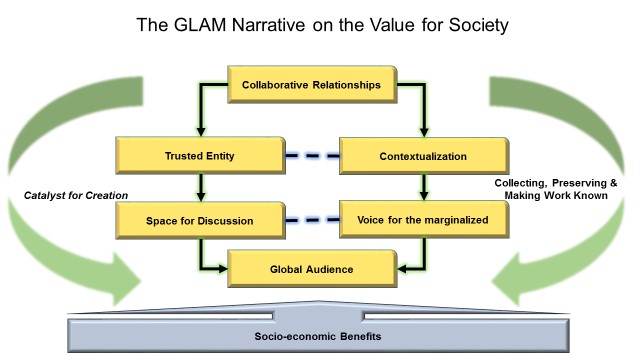
Figure 1 - Text version
The GLAM narrative on the value for society is represented by an infographic. At the bottom of the image, a grey upward arrow entitled “Socio-economic Benefits” leads to a central schematic linking six yellow boxes with arrows. At the top, from a box entitled “Collaborative Relationships” are two green arrows, one leading down to a first box at the left entitled “Trusted Entity” and a second at the right entitled “Contextualization”. From these two boxes, an arrow from the left box leading down to a box entitled “Space for Discussion” and another arrow going down to a box at the right entitled “Voice for the marginalized”. The two left boxes are linked with dotted lines with the two boxes at the right. From these two lower boxes, two arrows are leading down to a box entitled “Global Audience”. Two light-green arrows starting from the top and leading down frame the entire schematic. The left arrow is entitled “Catalyst for Creation” and the right one is entitled “Collecting, Preserving, and Making Work Known”.